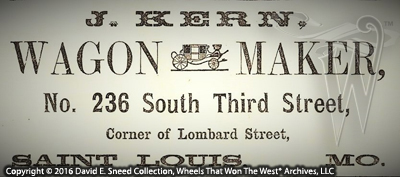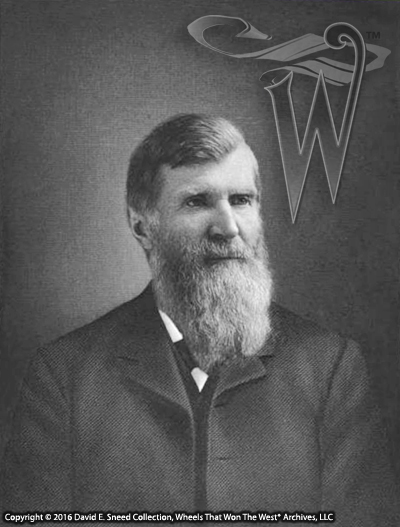As most of our regular readers know, when it comes to the wheels that built the American West, we share a tremendous amount of history inside each of our weekly blogs. Even so, there's a lot more information located in our maker archives and ongoing research files. As I've mentioned before, the depth of this subject is so vast that it's hard to find a single early source outlining what happened with who, when, how, where and why. So... what early assets do we rely on?
First and foremost, we look to as many primary sources as possible. Original promotional literature, photos, business correspondence, government records, period articles and books, unaltered vehicles and parts, old directories, and even obituaries can provide valuable insights into America's firs ttransportation industry. Firsthand experiences are also importance resources. To this day, I regret not talking more about this topic with my grandparents and greatgrandmother while I had the chance.
 |
| While this advertisement dates to the mid-1860's, an earlier 1859 promotion published by Mr. Kern offers "substantial" wagons for emigrants and miners moving west. |
My great-grandmother was born in 1884, less than eight years after the Battle of the Little Big Horn. Growing up near Indian Territory in western Arkansas, she lived more than 100 years, witnessing massive product innovations and equally significant lifestyle changes. She was 11 years old in the spring of 1895; the same timeframe that saw the passing of a number of legendary wagon makers such as Jacob Kern of St. Louis and O.R. Johnson, the then-owner of Fish Bros. Wagon Company in Racine,Wisconsin. That same spring, one of the originators of the legendary Studebaker Wagon Company also passed away. Understandably, news of Henry Studebaker's death was covered by many news outlets. Immediately below is one of the accounts as it was published in the April 1895 issue of the trade magazine known as The Hub...
"Henry Studebaker, one of the founders of the great Studebaker wagon establishment at South Bend, Ind., died March 2d, aged sixty-eight years.
Mr. Studebaker was born at East Berlin, in Adams County, Pa., October 5, 1826. He was the sixth of a family of thirteen children born to John and Rebecca Studebaker. The family emigrated to Ashland County, O., when Henry was nine years of age. Serious reverses had overtaken them in their old home, and they made the trip from Pennsylvania to Ohio across the Alleghenies, with all their earthly belongings in an old fashioned "schooner" wagon, built by the father, who was by trade a blacksmith and wagon maker. Henry was apprenticed to a country blacksmith, working at the forge in summer, and going to district school in the winter. Later he returned to the family home and completed his trade with his father and brothers, Clem and J.M., at the old shop near Ashland.
In 1847 Henry had accumulated enough to buy a horse, and with a few extra dollars in his pocket he started out to seek his fortune in the West. He went to Goshen, Elkhart County, Ind., and there engaged to work at blacksmithing. He sold his horse, intending to have no temptation to yield to homesickness and go back to Ashland. But at the close of several months' service, without other pay than his board, all the compensation which his employer was able to give him was an old silver watch. Discouraged with this experience, he turned his face homeward, and walked the entire distance from Goshen to Ashland, O.
In 1850, Clem Studebaker went to South Bend, and the next year Henry and the rest of the family followed. This trip the family accomplished in two wagons, mainly constructed by Henry himself for this especial purpose. In February, 1852, Henry and Clem Studebaker, with a joint capital of $68, opened a blacksmith shop for horseshoeing and wagon making in South Bend. There, under the firm name of H. & C. Studebaker, was instituted to the business to-day known to the world as that of the Studebaker Bros. Manufacturing Company.
In 1858, the business had become prosperous for the time, and as hard work at the forge had told on his health and strength, he sold out his interest to his brother, J.M, purchased land and turned his attention to farming, making the same success at that calling as in manufacturing, and left behind him a handsome rural estate."
In between horseshoeing and general blacksmithing work, Henry and Clement managed to build two wagons during their first year - a far cry from the 100,000 annual production mark the firm would eventually achieve. Their first significant financial shot-in-the-arm came as a result of instabilities in Utah during 1857. During those events, Army orders for wagons provided important cash flow for the duo. Even so, as a pacifist in the Dunkard faith, Henry is said to have had difficulty accepting the company's role in war conflicts. He eventually left the business, selling his share to another brother, John Mohler (J.M.), in 1858 for $3,000. More government contracts came during the Civil War and production rates gradually climbed to 8 completed wagons per week.1 The Studebakers weren't slowing down and, by the late 1860's, the brand was going head-to-head on the frontier with well-established western freighting brands like Espenschied and Joseph Murphy.2 By the end of the 1870's, the company was producing around 20,000 horse-drawn vehicles annually. Through each of these and subsequent eras, the wagon designs and paint configurations continually changed as part of the company's commitment to brand excellence.

Henry Studebaker was the oldest of the five Studebaker brothers.
From the first wagon built in 1818 by the brothers' father, John Studebaker, to the last Studebaker wagon built in1920, the family name became synonymous with exceptional quality, innovation, and leadership. Today, collectors clamor over just about any original vehicle truly authenticated as a Studebaker. It's a badge of honor and a continual reminder of what brand-building success looks like. After all, as of this writing, it's been at least 50 years since Studebaker built automobiles and almost a full century since they constructedthe last horse-drawn wagon in South Bend. Even so, the name remains extremely popular among collectors and, for those willing to dig a little deeper, primary source documents can add even more appreciation to a world of antique wooden wheels.
1According to "Land Owner" periodical records within the Wheels That Won The West® Archives.
2 D.P.Rolfe - Early wagon freighter, Wheels That Won The West® Archives
Please Note: As with each of our blog writings, all imagery and text is copyrighted with All Rights Reserved. The material may not be broadcast, published, rewritten, or redistributed without prior written permission from David E. Sneed, Wheels That Won The West® Archives, LLC